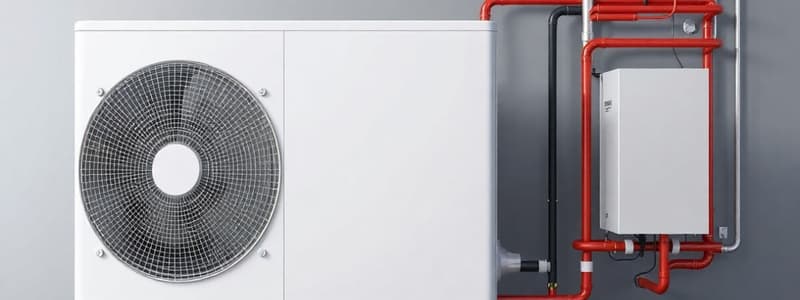Podcast
Questions and Answers
What is the primary function of a refrigerator?
What is the primary function of a refrigerator?
- To generate heat
- To increase the temperature of a region
- To create energy
- To remove heat from a low-temperature region (correct)
According to the Second Law of Thermodynamics, heat can spontaneously pass from a cold region to a warm region without energy input.
According to the Second Law of Thermodynamics, heat can spontaneously pass from a cold region to a warm region without energy input.
False (B)
What is the term for the measure of a heat pump's efficiency?
What is the term for the measure of a heat pump's efficiency?
c.o.p.
A common refrigerant used in refrigeration systems is ________.
A common refrigerant used in refrigeration systems is ________.
What is the vapor compression cycle used for?
What is the vapor compression cycle used for?
Heat pumps and refrigeration cycles are fundamentally different processes.
Heat pumps and refrigeration cycles are fundamentally different processes.
In the context of a heat pump, what does 'AQ' represent in the efficiency equation?
In the context of a heat pump, what does 'AQ' represent in the efficiency equation?
A refrigerator cycle is a ________ cycle that involves a refrigerant changing states.
A refrigerator cycle is a ________ cycle that involves a refrigerant changing states.
Where are heat pumps commonly applied?
Where are heat pumps commonly applied?
The coefficient of performance of a heat pump is independent of the temperature difference.
The coefficient of performance of a heat pump is independent of the temperature difference.
Flashcards
Thermodynamic Cycle
Thermodynamic Cycle
A sequence of state changes where a refrigerant returns to its initial state.
Refrigerator
Refrigerator
A machine that removes heat from a low temperature region.
Second Law of Thermodynamics
Second Law of Thermodynamics
Heat will not spontaneously flow from cold to hot without external work.
Heat Pump vs. Refrigerator Cycle
Heat Pump vs. Refrigerator Cycle
Signup and view all the flashcards
Coefficient of Performance (COP)
Coefficient of Performance (COP)
Signup and view all the flashcards
Study Notes
- The aim is to study the refrigerator cycle (thermodynamic cycle) and determine the coefficient of performance of the heat pump as a function of the temperature difference.
- Refrigeration systems are based on a thermodynamic cycle operating between two different temperature sources.
- In this cycle, a refrigerant (e.g., R134a) undergoes changes of state in a defined sequence, returning to its initial state.
- A refrigerator removes heat from a low-temperature region, and this heat must be dissipated to the surroundings.
- According to the Second Law of Thermodynamics, energy or work must be expended to move heat from a cold to a warm region.
- A refrigerator requires energy input to operate.
- Heat pump and refrigeration cycles are the same, but heat pumps utilize the emitted heat, whereas refrigeration systems benefit from the absorbed heat.
- Vapor Compression Cycle is one of the common refrigeration systems in use today.
- The most important applications of the heat pump are design of the refrigerators and the air-conditioned devices.
- The efficiency of the heat pump is given by the relation: c.o.p. = ΔQ/ΔW.
Studying That Suits You
Use AI to generate personalized quizzes and flashcards to suit your learning preferences.




